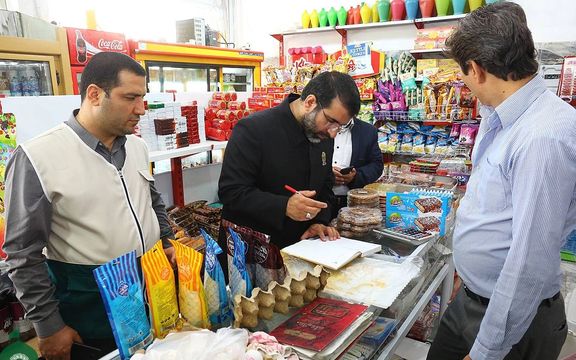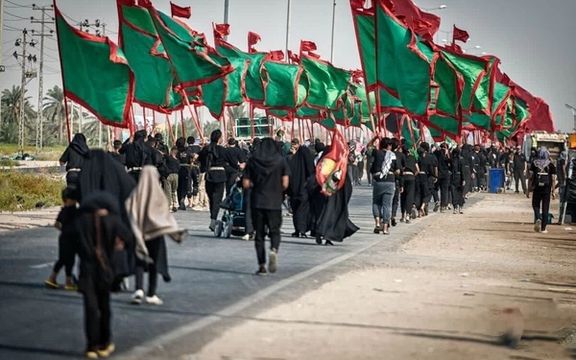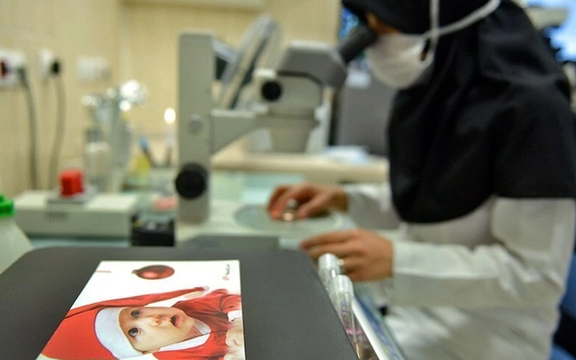Filmed assaults on women in Iran spark outrage

Two attacks on women in Iran caught on video, a very violent one on the street and another at a professional forum, have sparked outrage and highlight what critics call systemic gender-based repression.

Two attacks on women in Iran caught on video, a very violent one on the street and another at a professional forum, have sparked outrage and highlight what critics call systemic gender-based repression.
On Monday, women's rights advocate and journalist Masih Alinejad shared a video showing a man kicking a woman to the ground apparently after her headscarf slipped off in the southern Iranian city of Gachsaran.
According to Alinejad, the man had been attacking women who were not following Iran’s mandatory hijab rules. He wears military-style camouflage trousers in the manner of Iran's domestic enforcement militia the Basij.
“He’s not a lone wolf. He is a product of a system that trains men to police, punish, and humiliate women,” Alinejad said on X, calling the act “state-sponsored gender apartheid.”
She also criticized foreign governments that continue to engage diplomatically with Iran, saying this amounts to legitimizing the state’s repressive policies toward women.
Separately, during the annual assembly of the Isfahan Building Engineering Organization, a female member who reportedly questioned the body’s financial practices was physically assaulted by another attendee.
The incident, captured on video, sparked backlash on social media and was denounced as another example of institutional tolerance for violence against women in the country.
The cases follow nearly three years of heightened tension over women’s rights in Iran, beginning with the death in police custody of 22-year-old Mahsa Amini in September 2022.
Amini had been detained by the morality police for allegedly violating hijab rules. Her death triggered widespread protests and a violent state crackdown in which hundreds were killed and thousands arrested.
Since then, authorities have expanded surveillance and enforcement measures, drawing condemnation from international human rights groups.

Attacks on Israeli military, intelligence and scientific centers in a 12-day war in June demonstrated Iran's ability to hit its enemy's critical defense infrastructure, a senior official affiliated with the office of Iran’s Supreme Leader said on Monday.
The targets included major Israeli defense contractor Rafael and research institution the Weizmann Institute of Science, said Mehdi Abbasi-Mehr, political director of the Supreme Leader’s office in Iranian universities.
“We hit the Rafael factory. Go search the internet. Rafael made $3.5 billion in profit in one year. Rafael is the manufacturer of the Iron Dome. Manufacturer of David’s Sling and Arrow 3,” Abbasi-Mehr told a public forum referring to missile interceptors.
“Everyone in the world who uses a shoulder-launched Spike bought it from Rafael.”
Missile attacks on June 16 and June 20 targeted the company's facilities in the northern Israeli city of Haifa.
Rafael Advanced Defense Systems is a key Israeli state-owned weapons manufacturer responsible for some of Israel’s most prominent missile defense platforms.
Iranian forces also targeted the Weizmann Institute of Science, added Abbasi-Mehr, who described it as “the strategic brain of Israel’s science and technology,” alleging it is key to Israel’s nuclear, missile and biological research.
The Weizmann Institute of Science was established in 1934 as a public research university in Rehovot, fourteen years before the State of Israel was founded.
A June 15 attack on what researchers have called Israel's "crown jewel of science" destroyed as many as 25 labs according to local media reports, with no public indication that defense-related projects were hit.
“They have major defense contracts,” Abbasi-Mehr said, adding that the institute’s affiliated activities are located in the Gav Yam Science and Technology Park. “We hit Gav Yam.”
The Gav Yam site, also known as the Negev Advanced Technologies Park, is a technology park founded in 2013 in Be'er Sheva, located in Israel's Negev Desert.
Abbasi-Mehr claimed additional hits on Israeli C4 command centers and Aman, the military intelligence directorate, where he said Unit 8200 — Israel’s signals and cyber intelligence division — is based.
“The footage exists,” he said. “Despite their censorship, the footage exists. And we hit all of it during the day. All of it was hit during daylight.”
His comments follow a July report by The Telegraph citing radar data from Oregon State University showing Iranian missiles struck five Israeli military facilities during the June conflict. That analysis indicated damage to an air base, a logistics hub and an intelligence site.
The Israeli military did not confirm the specific damage but said operations remained “functionally continuous.”
The 12-day war left over 1,000 Iranians dead and thousands more injured. Israel reported 29 deaths, mainly civilians, and over 3,000 wounded.
A brokered ceasefire ended the conflict after extensive drone and missile exchanges.

As inflation continues to erode household incomes in Iran, a growing number of corner shops and grocery vendors across the country are quietly reviving an old tradition: the ledger-based, buy-now-pay-later system, Iranian daily Etemad wrote on Monday.
Once limited to big-ticket items like furniture or electronics, installment purchases are now being used to pay for daily essentials, from fruit and rice to detergent and chicken.
According to Etemad, field reports from Tehran and other cities suggest that even small neighborhood grocers and butchers are offering informal credit lines to loyal customers, often without collateral, checks, or formal agreements — simply on trust.
“They come every week and settle their bills at the start of the month, once salaries come in,” said one Tehran shopkeeper. “It’s like an installment plan — just between us.”
Strain breeds new norms
The practice, known locally as “hesab-daftari” (ledger credit), is expanding rapidly amid what economists describe as a deepening period of stagflation — a toxic mix of high inflation and economic stagnation. The article says the shift reflects a broader trend: the normalization of debt as a tool for day-to-day survival.
“In the past, installment buying was for luxury goods,” Etemad cited Ahmad Janjan, an economist based in Tehran. “Now it’s a way to afford bread and shampoo.”
He added that this shift is driven primarily by falling real wages, lack of liquid savings, and the rising cost of living.
From credit apps to corner stores
While fintech platforms like Digikala and Snapp Pay – Iran's top online markets -- have introduced digital installment options with slogans such as “no check, no guarantor,” it is the informal, person-to-person credit that is becoming more prevalent.
Some meat shops now allow buyers to split payments for poultry and beef. In produce markets, fruit vendors maintain handwritten tabs for repeat customers. Others offer agreements on mutual trust, sometimes in exchange for steady patronage.
'Buy now, pay more'
But not everyone is embracing this development as a lifeline.
“The shirt I bought online cost me 1,500,000 rials (about $2) more than in the store,” one customer wrote on social media. “But the store wouldn’t sell in installments. I had no choice.”
Others raised concerns about hidden fees and rising consumer debt. “This isn’t just delayed payment,” another user commented. “It’s disguised interest — and it adds up.”
Etemad cited Iranian economists as warning that while installment buying can temporarily soften financial blows, it also carries long-term risks in the absence of consumer protections or reliable credit scoring systems.
“There are no unified regulations on this,” said Janjan. “People may end up with debt they can’t service, all for everyday necessities.”
The growing reliance on credit is also changing spending behavior. Morteza Afghah, another economist, told the daily, “You get what you need today, but repayment obligations can pile up and strain households even more.”
Afghah links the trend to "deep-rooted structural issues, including political instability, bureaucratic inefficiencies, and unstable regulation — all of which raise production costs and feed into the country’s chronic inflation."
He warned that installment-based purchases are becoming more diverse fast, attributing the trend to what he called "stagflation."
“We are not only facing inflation and recession at the same time, but their combination — stagflation — has become a chronic condition in Iran’s economy, making it more difficult and time-consuming to address.”

Mofid Hosseini Kouhsari, deputy for international affairs of Iran’s seminaries, has called on Iranian pilgrims traveling to Iraq for the upcoming Arbaeen pilgrimage to refrain from criticizing forces aligned with Tehran, including the Iran-backed Hashd al-Shaabi militia.
“Hashd al-Shaabi ensures the security of Arbaeen,” Kouhsari said. “We should not say anything that undermines the importance of our allies or the resistance forces. This is a shared position we must uphold.”
He cautioned against openly voicing political opinions about Iraqi factions, warning that doing so could trigger internal tensions. “There is no reason for our pilgrims to speak freely and recklessly about Iraq’s political currents. God forbid it leads to discord,” he added.
Since the 2003 US invasion that ousted Saddam Hussein, numerous militias have emerged in Iraq, many with ties to Iran. Following the outbreak of the Israel-Hamas war in October 2023 and the recent Israel-Iran escalation, including US strikes on Iranian nuclear sites, the pro-Iran factions have periodically targeted US bases in Iraq.
Groups within the Popular Mobilization Forces (PMF), an umbrella group of mostly Shia armed groups originally formed to fight the Islamic State and then integrated into Iraq's security forces, have been among those involved.
A focal point of US-Iraqi tensions lies in the future of the PMF. Though nominally under Iraqi military command since 2016, many PMF units maintain strong ties to Iran and operate with broad autonomy.

Iran’s judiciary is investigating claims that frozen embryos were lost or misidentified at a state-affiliated hospital in Tehran, in a case that has deepened concerns about trust and oversight in the country’s fertility services.
Sajjad Razavi, deputy health minister for treatment affairs, confirmed Sunday that the case will soon be submitted to the prosecutor’s office.
“The issue is under review, and the file is being completed,” Razavi told Tasnim News Agency. "Any violations are under investigation, and the final decision will be made by the judiciary."
The embryos have since been moved to a different medical center “in coordination with the owners,” he said.
The controversy surfaced after Shargh newspaper reported on July 29 that multiple frozen embryos stored at Aban Hospital in Tehran had disappeared or been wrongly transferred.
Four months earlier, the hospital had abruptly shut down its IVF unit without informing families who had stored embryos, sperm, or eggs.
Families discovered the issue by accident, and in some cases were told that their embryos were either missing or delivered to the wrong recipients during the relocation process.
In vitro fertilization (IVF) is permitted in Iran under religious guidance. Demand for fertility services has surged in recent years as the country grapples with declining birth rates, rising infertility, and widespread economic uncertainty delaying marriage and childbearing.
Government policy has increasingly emphasized population growth, with officials urging couples to have more children. However, access to fertility care remains costly and largely urban-centered, driving some to entrust long-term embryo storage to major hospitals.
Aban Hospital is run by Iran University of Medical Sciences and falls under the Health Ministry.
However, health officials have denied any wrongdoing. “The embryos were being preserved under proper conditions,” Mohammadreza Foroughizad, head of public relations at the university, said on July 30.
University president Nader Tavakkoli dismissed the affair as a misunderstanding caused by temporary renovations and said no embryos had been harmed.
But Shargh reported that police visited the hospital on July 28 and formally registered family complaints. Many families still do not know where their frozen embryos are.
They are demanding accountability, judicial action, and compensation for damages, as well as the safe return of their biological material.

Iran’s Supreme National Security Council (SNSC) has approved the formation of a Defense Council to coordinate military planning and strengthen the armed forces, the state-run IRNA news agency reported on Sunday.
The Defense Council will focus on “defense strategies and strengthening the operational readiness of Iran’s military forces,” IRNA's report said citing SNSC's secretariat.
The secretariat said the Defense Council has been formed within the framework of Article 176 of the Constitution of the Islamic Republic, which allows the SNSC to establish “subsidiary councils such as the Defense Council and the National Security Council” in accordance with its responsibilities.
President Masoud Pezeshkian will chair the council, which will include the heads of the executive, legislative, and judiciary branches, as well as top military commanders and key cabinet ministers, the report added.
The Council already existed in the Islamic Republic's Constitution and is now being revived decades after it was active during the early years of the Iran-Iraq war in the 1980s, Mansour Haghighatpour, a politician close to Ali Khamenei's advisor Ali Larijani, told Eghtesad News on Saturday.
The Defense Council played a key role in Iran's military decisions during the 1980s.
Fars News, an outlet linked to the Revolutionary Guards, said Friday the Defense Council is part of a wider reconfiguration of Iran’s security apparatus.
Tasnim News, which is also close to the Islamic Revolutionary Guards Corps, said the body is intended to oversee national defense policies and streamline military decision-making.
"The Council's objectives appear to be supporting the comprehensive strengthening of the country’s defense capabilities, as well as accelerating and improving the efficiency of decision-making in the defense sector," the Tasnim report said.
The revival of the Defense Council is a positive development, Haghighatpour said on Saturday, adding that it would transform the General Staff of the Armed Forces into a coordinating body rather than a commanding one.
“If we face serious conflict and our forces are to enter the field—considering that the army and the Guards constitute a combined force, with two air forces, two ground forces, and two navies—all engaging together requires a central command,” he added.
“Command must have a designated deputy, ensuring we are not caught off guard at critical moments.”
The Tasnim report said that “given the new security challenges and the complexity of regional and global threats, the revival of the Defense Council could lead to greater agility and focus in the country’s defense decision-making.”
Iran International's senior analyst Morad Vaisi believes the formation of the Defense Council is not meant to defend the people or the country but "to defend the Islamic Republic and prevent its collapse.”
“The surprise in the 12-day war has shaken Khamenei’s confidence in the military commanders, and he is now seeking to build more institutions above the IRGC, army, and the General Staff of the Armed Forces," Vaisi said.
During the conflict with Iran in June, Israel's air force took control of Iranian airspace, delivering a significant blow to the country's air defenses, while Iran's armed forces responded with successive waves of missile and drone attacks on Israeli territory.
Israeli military officials say that 120 air defense systems were destroyed or disabled since the first wave of attacks—around a third of Iran’s pre-war total. Long-range systems, including Russian-supplied S-300s and Iran’s Bavar-373 batteries, were among those targeted.
Tweet unavailable